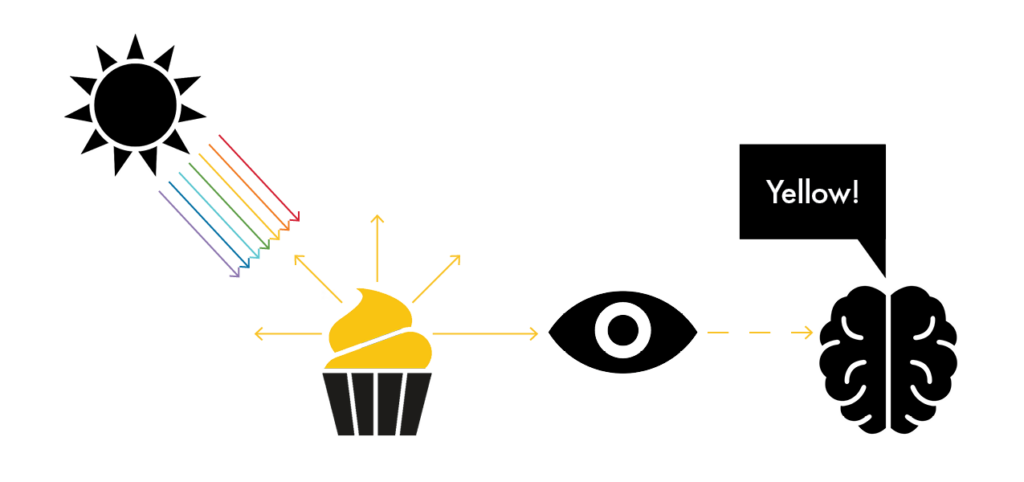Color gives us loads of information about nature, beauty, other people, and even perils that surround us. We often take color for granted and we don’t imagine the immense amount of evolutionary effort involved in that capacity. But have you ever wondered, what is color, and why do we see in color? In this article, we’ll talk about some of the science behind how and why we see in color.
What is color?
Color is not an objective characteristic of the objects we see but is a combination of a perception and interpretation of the light that they reflect.
Light is the visible portion of the electromagnetic spectrum, and it sometimes acts as a wave and sometimes as a particle. Here we will explain color using the classic color theory that involves light behaving like a wave.
Think of light as a wave – as if it was a guitar string vibrating when it is strummed. The faster it vibrates, the shorter the waves. The distance from a crest of the wave to the next is what we call a wavelength. Visible light ranges from 400 to 700 nm (that is tiny!) and the brain interprets these different wavelengths as colors.

Now, let’s imagine the light is bumping into an object, like a lemon-yellow cupcake. There are molecules in the cake that absorb light selectively: meaning they only catch the light of certain wavelengths (we call them pigments, like beta-carotene) and they also reflect back a combination of unabsorbed wavelengths. That portion of light that is reflected is what we perceive as color.

Certain wavelengths of light are preferentially absorbed by pigments, while some others are reflected. The light that is reflected is perceived by our eyes and interpreted by our brain as color.
Our sensors and processing center
So how do we perceive these colors? We have specialized cells in our retinas called rods and cones. The rods are capable of sensing light even when there is very little, like when we see an object’s shape in the dusk in shades of gray. Cones, on the other hand, have pigments that – like all pigments – have a preferential absorption of certain wavelengths. Humans have three types of cones specialized in a segment of the light spectrum. That is why it is said that we have a trichromatic vision. The S cones detect short wavelengths (violet to blue light), the M cones detect medium wavelengths (green light) and the L cones are in charge of long wavelengths (yellow to red light), with some significant overlapping between them as you can see in the diagram below.
The signals from these three receptors are compared with each other in a process called ‘cone opponency’ and then processed and interpreted by our visual cortex as color! As an analogy, think how screen monitors work with red, green and blue lights (RGB), or the way that printers can give you any color with combinations of magenta, cyan and yellow inks.

But why do we see in color?
However, not all animals see colors in the same way humans do. Most terrestrial mammals like dogs and cats are dichromatic. This means that they have only two types of cones and can’t see parts of the spectrum that we are able to see. Some species of birds, fishes or reptiles, on the other hand, have four types of cones: they are tetrachromatic. Some animals are even able to see in the ultraviolet range or the near infrared. How cool is that?!
Humans share trichromacy with other primates, which suggests an evolutionary process where our ability to distinguish colors allowed us to succeed as a species. One theory indicates that trichromacy is good for social interactions, because it permits us to properly distinguish our peer’s face features and how these express emotions and ideas, ultimately leading us to collaborate.
Another theory explains that color vision facilitates the optimal discrimination of our food sources: intensely colored fruits are a sign of maturity and energy density, while bright green young leaves are fresh, edible and good for us. It also permits us detect food that is potentially poisonous, especially if we have prior personal or cultural information about it, or reject rotten or contaminated food, that is often moldy green, blue, or black.
In that sense, color has become an essential part of the communication of quality and the appeal of foods of all sorts. Color information also leads the way for other sensory perceptions like flavor identity, flavor identification, aroma, and of course deliciousness!
Let’s take a look around us and appreciate our colorful world, and that awesome evolutionary ability that allows to enjoy – with our eyes first – that lemon-yellow cupcake that has been in your mind since we first mentioned it!






